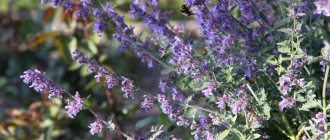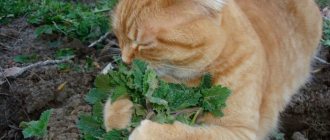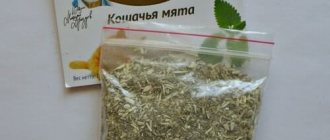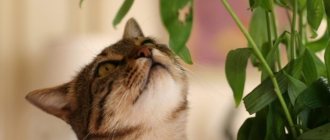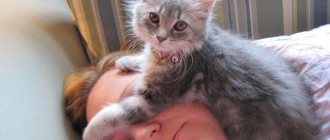Contraindications and restrictions
Veterinarians do not recommend giving catnip to pregnant females. Under the influence of essential oil, the animal may experience severe agitation. This quickly depletes the cat's nervous system. Stress during pregnancy has an extremely negative impact on the condition of the mother of the offspring. Before the kittens appear, it is better to remove the pot with the plant. However, it is worth taking into account the animal’s intuitive sense. If your cat goes outside and starts sniffing mint, you shouldn’t stop her from doing so.
Another contraindication is the animal’s uncontrolled behavior after eating grass. If a cat, after eating or sniffing, becomes agitated and aggressive or falls into a stupor, you should not give it grass.
Is it harmful to cats?
Having eaten too much grass, the animal will begin to roll on the ground. Excessive consumption of the plant can cause the animal to meow loudly, convulsively move its paws, jump in place and roll on the ground. The Peppermint Cat often also hallucinates and experiences a feeling of euphoria. However, according to veterinarians, the symptoms do not pose a threat to the life and health of the animal. Veterinarians prohibit giving mint to pregnant cats, since excessive stimulation can have negative consequences for babies in the womb. There is a risk of premature birth. Mint is also harmful for cats, which react very sharply to odorous aroma - an outburst of emotions will deplete the central nervous system. With frequent use, sensitive pets will develop neurosis. The plant will not harm kittens and cats, but if the pet does not like catnip, then it should not be forcibly introduced into the diet.
Types of catnip
Catnip is sold in pet supply stores and comes in different forms.
Tablets and vitamins
An excellent addition to cat food are tablets and vitamins that contain catnip. They have a beneficial effect on the nervous system and enrich the body with useful substances. The smell of nepetalactone encourages the cat to eat the whole complex of vitamins with pleasure.
You can easily purchase fortified treats in specialized stores. Various manufacturers offer their products.
Vitamins with catnip
Sprays and drops
Products with a fairly long shelf life are sprays and drops for cats. They are used to attract pets to the required place. These substances can be sprayed as needed.
Incense sticks for chewing
If it is difficult for your cat to get used to brushing its teeth, then a chewing stick with mint will come to the rescue. Over time, you can use regular remedies.
As part of scented toys
Scented toys contain the scent of cat weed. They are very attractive to furry pets. When purchasing, you should study the label. It is good that only leaves and flowers are used when filling, and not tough stems. Low-quality fillers only add volume and do not have the desired effect.
Toys with grass sewn inside can be very different in shape and color. For example, mice, balls, bananas, etc. They promote active play of animals.
Soap bubbles with an extract of mint essential oils are also intended for the game.
Over time, the smell of catnip weakens. To ensure that your animal continues active play with its favorite toy, you can spray mint on it in the form of a spray. The cat will again react to the forgotten item and show keen interest.
You can buy quality weed in bulk and fill the toys with it yourself. You should beware of tough plant stems, especially if your cat likes to chew on them. The animal may get hurt.
Experienced breeders advise buying several fur mice and placing them in a container with grass from time to time. The toys will acquire the smell of real mint, and cats will be happy to play with them.
Toys for cats
Additional Information! There are many different types of catnip. If desired, it can be grown at home on a windowsill or in the garden. The plant is unpretentious, quickly accepted, and reproduces well. Seedlings can be bought at the market or in a specialty store.
Catnip will be fun for your pet on a walk. The owners can have fun watching his behavior. Please note that the plant will also attract neighboring cats.
Application area
People have many questions: is catnip healthy, what is it for, where and how to use it. Veterinarians often use catnip to calm pets. This is a natural remedy that allows you to correct the animal's behavior pattern. Unlike synthetic sedatives, it does not have a negative effect on your pet and does not cause side effects.
The plant has the following benefits for cats:
- for colds and stomach pain, essential oils and phytoncides have an antibacterial effect and relieve spasms;
- increases appetite, preventing exhaustion of the animal’s body during illness;
- helps you cope more easily with stress when moving, renovating or buying a new pet;
- Suitable as an antiparasitic agent as an additional therapy when taking a course of anthelmintic drugs.
The main advantage of a natural remedy is the lack of addiction in your pet. Despite the acute reaction of the nervous system, the period of excitation does not last long and passes without leaving a trace on the general condition of the animal.
Manufacturers of pharmaceutical companies that are focused on the production of veterinary drugs became interested in the unusual reaction of pets to mint. They have created a line of medicines with catnip essential oils, essences or liquid extracts. Veterinarians do not recommend giving dried parts of the plant and products with catnip more than once a week.
Concentrated solutions are used in the following cases:
- Control of aggressive behavior. An irritated pet should be given a plant leaf or a piece of cloth soaked in the extract. Nepetalactone contained in the oil has a sedative effect on the nervous system, which allows you to control the animal’s behavior.
- For cats with increased physical activity. If you give your cat a cloth or paper soaked in oil, he will calm down and stop running around the apartment, destroying fragile objects and scratching upholstered furniture. This technique helps in training kittens, which become calmer and more controlled as they grow older.
- Buying an adult animal. It is difficult to train cats and kittens over 1 year old to use a litter box. Therefore, owners often resort to using catnip. From 5 to 10 drops of liquid extract mixed with sand for the tray, a conditioned reflex is developed in the animal. Thanks to this, the cat will go to the litter box. A similar principle is used to accustom a pet to a new bed.
- If a cat uses upholstered furniture to sharpen its claws, special scratching posts are sprayed with catnip essence.
- You can fill soft toys or a ball with cotton wool soaked in the medicine. Thanks to this effect, the cat will not get bored in the absence of the owner and tear up the furniture. The cotton wool will need to be changed every month because the oils evaporate quickly. Ready-made toys with catnip are sold in pet stores.
- the reaction speed increases;
- memory improves;
- people become less irritable;
- cognitive functions increase;
- a person can more easily focus on the task at hand;
- the psycho-emotional state is normalized, resistance to stress increases.
In folk medicine, catnip is used to treat colds, migraines, and digestive problems. Women are advised to use horehound decoctions for painful menstruation. When used externally in the joint area, mint medicines help relieve inflammation and improve tissue microcirculation.
Bags of crushed and dried leaves of the plant can be hung around the apartment. Essential oils repel insects and small rodents, so there will be no pests in the house.
Appropriate place
Catnip prefers sunny places; in the shade and partial shade its flowering becomes much poorer, so choose a well-lit area for planting. This plant also feels great in group plantings; it goes well with other flowers, as long as the soil is sandy and loose. Heavy fertile soils are completely unsuitable for catnip.
Catnip is very frost-resistant, so there is no need to additionally cover it for the winter or be afraid of strong winds and drafts; this flower doesn’t care about anything.
The only thing that should be taken into account when choosing a suitable location is the location of groundwater and it is better if the selected area is on a hill, then excess water will not stagnate near the roots.
Growing and storing catnip
Catnip is unpretentious, so it’s easy to organize a pot of healthy treats for your pet on the windowsill or allocate a bed in the country house or in the garden.
You can purchase catnip seeds or seedlings at garden stores. This plant is planted indoors in spring or autumn. The main condition for development is a sufficient amount of sunlight (if it is not enough, use a fluorescent lamp), otherwise the sprouts will turn out weak. Intensive watering is required only in the first 10–14 days, then you can wait for the soil to dry out by 5–8 cm. If the soil is too wet, the roots may rot, so you should not be zealous.
Catnip can grow indoors
Catnip is planted in open ground in the spring, immediately after the last frost. Leave about half a meter of space between the seeds and water for germination for the same 10 days. In most regions, catnip prefers well-lit places; this should also be taken into account when planning the location of the bed. Exceptions are areas with very hot and dry climates, where the sun at its zenith can damage the leaves - in this case, the area should be shaded in the afternoon.
You can plant catnip in open ground
Catnip can also be planted from seedlings - this method is preferable for obtaining strong, viable plants. In this case, the seeds are planted in early April to a depth of no more than a centimeter. Two weeks later, when the first true leaves appear, picking is done (plants are transplanted at a young age) and the seedlings are transplanted into separate pots. By May, the height of the seedlings reaches 10–12 cm, at least 3 pairs of leaves appear - this is the time of planting in open ground.
It is good to plant catnip from seedlings
Helpful Tips:
- When grown in the garden, catnip grows well, and there is a chance of getting a persistent aggressive weed. Therefore, when selecting a bed on a site, it is advisable to plan it separately from other crops and fence it with stones;
- A good idea is to plant catnip in garden containers that can be buried in the ground. Shoots that escape beyond its boundaries can be easily tracked and weeded out, and the roots will not spread to the rest of the site;
- if you remove faded flowers and cut the grass, the plants will become bushier and will bloom more often;
- To propagate catnip, you can divide the root system. To do this, you need to dig up several shoots, lower their roots into water and wait until the root ball is saturated. Then you need to divide it in half and plant it. This procedure will also prevent the plants from growing too vigorously;
- Overwatering is more critical for catnip than underwatering, so in indoor conditions it is better to use light, well-drained soil and check with your finger that the soil is dry before watering.
Collection and drying of catnip is carried out in the fresh air. You can trim individual leaves at the points of attachment to the trunk (useful for speeding up the growth of the plant), branches at the base, or take the entire bush. The most convenient way to dry catnip is on paper towels in a well-lit place; whole plants can be hung upside down. It is unacceptable to lay out the grass in armfuls: it will lose all its beneficial properties.
Dried catnip can be stored for about 2 years.
Over time, essential oils dissipate, so it is important to keep it in the refrigerator or other cool place in an airtight container or bag. You can grind the dry leaves in a coffee grinder or food mill and store them in glass jars with tight-fitting lids.
If you just want to try offering catnip to your pet without fussing with planting, buy it dried at a pet store. Sprays and aerosols based on the plant and various toys with its addition are usually sold there.
Well, if ready-made toys do not warm your soul, the assortment of a pet store can be used as inspiration for creativity: for a simple bag, a handful of dry catnip, a scrap of fabric and minimal sewing skills are enough.
Growing catnip in the garden
Why bother growing catnip if it can be purchased at any veterinary pharmacy. The answer to this question is simple: the natural product does not have any chemical impurities and its use will in no way harm your beloved pet. Another reason to start growing the species yourself is its decorative qualities and very pleasant aroma.
Catnip in the garden
Planting can be done in two ways:
- Direct planting in the ground.
- Seedling method.
If you plant seed directly into the soil, it is important to understand that the first shoots will appear no earlier than in 14-20 days. Sowing seeds in open ground can be carried out throughout the spring and even in the fall. On a note! Germination of seed directly depends on weather conditions
On a note! The germination of seed directly depends on weather conditions.
If you follow the rules of care, this extremely unpretentious plant will delight your pet this year and decorate any garden.
Sowing in the soil should be carried out in a light, drained substrate. Location: sunny side, or at least partial shade.
Watering the plantings is a mandatory procedure. Despite the fact that the plant tolerates drought well, it will definitely not refuse timely watering.
Important! It is necessary to moisten the soil after the first cutting to stimulate the restoration of the above-ground part. Organic and mineral fertilizers have proven themselves to be good for feeding catnip in open ground: humus or manure, as well as any superphosphate preparations
We must not forget about timely loosening after each watering and weeding of all harmful weeds
Organic and mineral fertilizers have proven themselves to be good for feeding catnip in open ground: humus or manure, as well as any superphosphate preparations. We must not forget about timely loosening after each watering and weeding out all harmful weeds.
If possible, you should not resort to cutting catnip shoots in the first year of life. This will create a stronger and stronger plant.
To achieve flowering this season, you should use seedlings as planting material. Seeds for seedlings are sown at the very beginning of March. Transplantation into the ground is carried out in May, after the formation of the first true leaves.
By summer, the bush will grow greatly and if you do not carry out decorative pruning, in the fall it will self-sow as abundantly as possible.
Useful properties of catnip
This plant is not only decorative, but has also been used by humans since ancient times, including for the treatment of various diseases . Today catnip is used:
- For medicinal purposes.
- In cooking.
- When creating various decorative garden compositions.
Landscape designers widely use various cultivated forms of catnip, which have an attractive appearance and differ in the duration of flowering. They are indispensable when arranging stone gardens and rockeries. Particularly impressive are the various decorative flower beds, which are made on the basis of catnip and other perennial herbs.
In cooking, catnip is used to give dishes a pleasant light aroma with hints of lemon. Dried catnip can be used as a seasoning for various meat and fish dishes.
Important. Pregnant women are not recommended to eat catnip.
How does it affect cats?
Almost every owner knows how catnip affects cats and why cats love this plant. Catnip oils contain the active substance nepetalactone. When it enters the nasal cavity, it irritates the olfactory receptors, easily penetrates the capillaries and, together with the systemic bloodstream, reaches the brain.
Neurons also have specific receptors that perceive the bioactive compound. When nepetalactone interacts with brain cells, animals experience short-term hallucinations.
Ethyl alcohol has a similar effect on humans. Cats intoxicated by mint often do inexplicable things. The animal's behavior pattern changes dramatically, so it can become either aggressive or calm, regardless of its character.
Often cats purr, roll on the floor, scream loudly or actively lick themselves. Mint enhances physical activity, so pets can jump high, climb without any purpose, or run around rooms.
The effects of the plant are short-lived because the neurotransmitters in the cat's synapses are depleted within 10 minutes of inhaling the lemon scent. As a result, the pet's brain stops responding to the plant's oils. The level of neurotransmitters is replenished after 60-70 minutes, so after this period of time the cat begins to behave unnaturally again.
Due to its high content of vitamins and microelements, catnip attracts animals. Cats eat the leaves, flowering shoots and stems of the plant as food. An animal can eat up to 100-150 g of mint, after which it stops.
Why do cats like the smell of this plant?
What mint looks like - varieties and names
It has been scientifically proven that the smell of lemon has a magnetic effect on a cat. The essential components of the plant, when they enter the cat’s nasal sinuses, give a lightning-fast signal to the hypothalamus of the brain and form a wide variety of animal behavior.
The magic of influencing a pet
The principle of influencing a cat
The smell of catnip leads to a truly euphoric reaction. The pet begins to spin and roll on the floor, accompanied by increasingly strong purring. When the brain is exposed to this smell, an animal very often experiences hallucinations. Veterinarians compare this reaction to intoxication. There are a lot of different individual reactions:
- loud rumbling;
- too active washing;
- unnatural jumps;
- climbing curtains;
- sleeping in an unnatural position.
In most cases, hyperactive behavior lasts for 10-12 minutes. After this, the cat usually falls asleep.
Cat's reaction to her favorite treat
The break in the euphoric reaction can last from 30 to 60 minutes and if inhaled again, all symptoms will recur.
Is catnip harmful to cats and when should it not be used?
Even the pet’s enormous interest in catnip does not allow it to eat more than the required amount. The animal has an internal barrier that does not allow it to eat “euphoric weed” continuously.
On a note! Even if this suddenly happened, cleansing the body after an excess of catnip occurs naturally: through diarrhea or vomiting. This situation does not require the involvement of a veterinarian or the use of any medications.
The only restriction on the use of catnip concerns pregnant representatives of the species. Females can become overexcited and their shaky nervous system will react negatively to stress.
It's important to remember that cats have a natural ability to sense which plants they need and which they don't. Therefore, there is no point in restricting an animal in outdoor conditions.
Cat's lemongrass
Why doesn't my cat react to catnip?
There is a hereditary feature of some cats, which consists in a lack of interest and reaction of the body to catnip.
Approximately 30-35% of cats completely lack the receptors responsible for the reaction to this herb. This may be due to age characteristics, but more often, if the reaction does not appear in a young kitten, then it will not affect an adult cat.
How much does it cost and where to buy
Catnip is a fairly tenacious and popular plant in Russia, sold in many pet stores and gardening nurseries. In special stores for animals, this grass is already sold in the form of a spray or dried, packaged in bags for ease of use.
Often, you can find ready-made toys for cats labeled catnip, which means that there is dried mint inside the toy.
In dry form, stores ask for 150-180 rubles for 15-20 grams of the plant; the spray will cost more - about 350-400 rubles per 100 ml, but it is much more convenient to use.
Where does catnip grow?
Cat mint grows wild in forests and fields of the Russian Federation; the plant is especially popular in the northern part of the country. Cultivated types of grass can be found in the design of borders in the city.
Since the esters of this plant cause attacks of euphoria in most cats, around it you can find flocks of animals rubbing against flowers and leaves. In this case, it is better not to let your pet close to the plant, since you can get many diseases and parasites from other cats.
How to grow catnip in a pot
If decorative catnip is not planted in the city, and there are no forests or fields nearby, you can purchase seeds in a store or market and grow the plant yourself in a pot.
After the seeds have been planted in the soil, it is better to place the mint pot on the windowsill on the sunny side. The grass does not need a lot of water; it is enough to water only when dry soil is found in the pot.
Use of catnip for medicinal purposes
Even in ancient times, this plant was widely used in folk medicine. Its properties are known to improve the general condition of the body and cure various diseases. Decoctions and infusions based on this herb are used for:
- Treatment of skin inflammations, rashes and suppurations.
- To relieve cramps.
- Decoctions perfectly improve the functioning of the digestive system.
- As a general tonic.
- Catnip is an excellent hemostatic and anti-cold remedy.
The effectiveness of decoctions and tinctures will largely depend on how correctly this medicinal herb is collected. You can cut catnip for drying only from two-year-old bushes. The grass is collected at the end of August and early autumn. It is recommended to cut young annual shoots for drying, leaving stems with a height of more than 10 centimeters. It is best to dry plants in bunches, using stems, flowers and leaves for medicinal purposes.
How to use catnip
Some owners believe that catnip has a negative effect on the pet's nervous system. This is a misconception. On the contrary, using catnip will help get rid of many problems, incl. psychological. Catnip can be used in situations where:
the pet has an aggressive character - just give him a little dried catnip. the cat is very playful and is capable of turning everything upside down in the house, the plant will have a calming effect on him; it is necessary to accustom the animal to the tray - you should put a little dry catnip under the container
The smell will attract the cat's attention, and the learning process will be faster and easier; the owner is going on a trip with the pet, or is planning a trip to the veterinary clinic - we recommend putting a few sprigs of catnip in the carrying bag, this will help relieve stress in the animal; the cat has recently arrived in the house and needs to get used to its new housing, it is recommended to place branches of the plant in the area of its sleeping place; the animal is passive and lethargic - a little catnip placed in toys will cheer it up; your pet has a stomach spasm - the bactericidal properties of catnip will help solve the problem; the animal refuses to eat - catnip will increase appetite; the cat sharpens its claws on the furniture and ignores the scratching post - you should carefully open the covering of the scratching post, place plant branches inside it and sew it up. The animal will smell the mint and leave the furniture alone
This is one of the most effective ways to train a dog to use a scratching post.
Attention! Catnip is indicated for cats infected with helminthic infestation. The plant prevents the proliferation of helminths
Catnip can be used both fresh and dried. When stored, the plant retains all its properties.
Pests
Catnip is almost never attacked by aphids, bedbugs, or other harmful insects. Moreover, it scares them away and does not allow them to settle on those plants that grow near it. At the same time, the pleasant lemon-mint aroma attracts some butterflies, which not only feed on the nectar of the catnip, but also lay their eggs on it. The caterpillars formed from them can cause irreparable harm to the plant. Considering the honey-bearing properties of catnip, it is unacceptable to fight them with the help of specialized chemical pest control agents. It is better to use safer traditional methods. Catnip does not have any specific diseases unique to this plant, so the gardener usually does not have any special problems with its cultivation. Of course, this is not an exotic plant, stunning the imagination with its beauty. But its fragility, velvety, tenderness will become a magnificent background for other, brighter colors. And given the beneficial properties it has, it will take its rightful place in your medicinal garden.
Application ↑
Lemon catnip has a pleasant aroma and many beneficial properties.
In medicine it is used to prepare tonic tea, improves immunity, has anti-inflammatory, analgesic and expectorant effects. It is used in gynecology, for gastrointestinal and colds. Catnip essential oil has a pronounced antimicrobial effect.
In the kitchen, it can be added to fish and meat dishes, and is also suitable for sweet dishes - compote and jam. And tea with a couple of lemon catnip leaves will relieve you of insomnia.
In addition to catnip, catnip has other ornamental species intended solely for beauty in the garden. You can see descriptions and photos here.
What is catnip for?
tray
What is catnip
This incredibly useful herb can be found almost anywhere - in gardens, meadows, fields and forests. There are almost 200 species of this fragrant herb. The plant can reach 100 cm in height. No description of the plant can convey the aroma that is inherent in it.
What does this fragrant grass look like? Its stems, as a rule, are uneven, and the flowers are tightly located to each other. The color of the flowers can be varied (pink, purple and white with amazing spots). In the photo there are sometimes unusual colors of the plant. The aroma of catnip combines the scent of rose and geranium with the addition of notes of lemon.
Where does catnip grow? The main countries where you can find mint include:
- America;
- Africa;
- all of Europe.
Considering the absolute endurance of the plant to any conditions, you can be sure that sooner or later it can be found in any corner of our planet.
What attracts cats to mint?
Felines are extremely sensitive to essential oils. They are especially attracted by floral-lemon notes. After sniffing such a smell, they begin to salivate, meow and wipe their heads on the floor. Occasionally, animals may bite their owner, jump on cabinets, or roll on the ground.
Such a performance lasts about 5-10 minutes. The cat will then return to a calm state.
What happens to the animal? This is an absolutely normal phenomenon, since the grass contains a narcotic compound. Most animals subconsciously strive to eat a little because of the fragrant essential oils that contain nepetalactone.
This component can cause a temporary hallucination in a cat as soon as it seeps through the pet’s nostrils. An irritating smell excites the nervous system. The amygdala generates information and transmits it to the area of the nervous system that is responsible for shaping the cat's behavior.
The lower part of the brain generates a neuroendocrine response that is similar to the behavior of a furry friend in heat. How susceptible a cat is to grass directly depends on its heredity.
Whether in the garden or in the vegetable garden
Since catnip looks very attractive, it is often included in flower mixes, borders and planted around the perimeter of the site. The fragrant aroma attracts some insects, especially wild bees (catnip is a valuable honey plant). Cats love to relax in the shade of lush bushes and have fun hunting crawling and flying “invaders”. Therefore, you should not plant this grass near valuable crops, since the cat will certainly trample the greenery growing around the catnip.
In order for catnip at home to delight you with its lush greenery and fragrant aroma, the soil in the pot should be light and not sour. Sufficient lighting and regular watering are important, but this plant does not like stagnant water at the roots.
Manufacturers of pet products have long figured out what catnip is for: since it is so attractive, why not use this property? Dried leaves can be hidden in a homemade toy or placed under the upholstery of a scratching post so that your pet is sure to use it. To make dietary food more attractive, you can add fresh catnip leaf or dried chopped grass to the dish.
Cats simply love toys with the scent of a simple plant - catnip. Some pets fall into euphoria, similar to, while others react more restrainedly. But there are few cats in the world who would be indifferent to the smell of catnip.
Catnip for cats is used as an aromatic stimulus (inducement to play, physical activity, awakening appetite) or a sedative (during sexual heat or severe stress).
Smells and, in general, the chemical composition of substances are much more important for cats than any other characteristics. So the smells of valerian and catnip have a tonic effect on our pets. Every catnip has known what catnip is since childhood - most commercial cat toys have this scent built into them.
Is it possible to give mint to a cat?
Beginning cat breeders believe that catnip is something like a narcotic. Not at all. Habituation (i.e., the development of immunity) is possible, but “drug addiction” is out of the question. The observed behavior is a momentary result, and not a manifestation of addiction.
In the case of valerian, the effect can still be destructive, since in case of overdose it leads to overexcitation of the nervous system and loss of control over behavior.
By the way, regular peppermint is not attractive to cats. Except sometimes – for individual gourmets. But it’s not for nothing that catnip was called that: it’s not interesting to humans, but cats are attracted to it in most cases. This is a safe plant, the delicate aroma of which has a mild, slightly intoxicating effect:
- Through the olfactory receptors, the aroma enters the body - directly to the hypothalamus, which is responsible for behavior. Hence such a quick and directed influence;
- The effect lasts 10-15 minutes, while valerian takes over the cat for several hours;
- A more pronounced hypnotic effect is observed compared to valerian. A dozing pet does not react to the smell again. Immunity lasts 1-2 hours.
Professionally Approved
Experts believe that the use of aromatic stimuli is an effective method in training and correcting the behavior of cats. Sometimes an animal needs to be concentrated on a certain place or object and form positive associations with it, for which catnip is ideal:
- In difficult cases, for example, when dealing with aggression, it is used as a sedative;
- As a phytocomponent, valerian and catnip are effective in correcting uncleanliness and destructive behavior (which also requires complex behavioral therapy and a course of re-education);
- It's good with catnip.
If your cat needs catnip, look in your local vacant lot: this free-growing plant can be found in almost any region. And if there is no time (or knowledge) for searching and preparing, then dried catnip greens are always sold.
It is best to look for it not on the lawn using a photo from the Internet, but in a pharmacy or specialty store. You can also grow it yourself on the windowsill all year round.
How to recognize catnip?
Mint, which is so selflessly loved by felines (even such huge cats as panthers and leopards), can be found everywhere:
- In the woods;
- in the garden;
- in vacant lots;
- on the river bank.
Even the name given by scientists to this herb reminds us of lovers of the wonderfully smelling plant. In the plant guide it is presented as lemon catnip or mint catnip.
There are about 200 varieties of catnip. However, not everyone knows what catnip looks like in nature. Its appearance is varied: the grass can be tall, reaching a height of 1 m, and some varieties grow no higher than 0.5 m.
The flowers of the plant look like small bouquets gathered together. Their color varies from white with a pink tint to slightly purple. The leaves resemble cut out hearts. But the main feature by which mint is distinguished from similar plants is its smell. This fragrance consists of a unique combination of geranium, rose and lemon scents.
Various subspecies of cat treats grow in almost every corner of the planet. Cats can smell the attractive scent of these plants from afar. It’s not for nothing that cat grass was placed in traps to attract wild cats. Why do these animals love mint so much and what attracts them to the plant? Let's try to understand this mysterious phenomenon.
general description
The scientific name of the plant is Nepeta Cataira, although people have come up with many other names for it, which reflect its inherent properties: catnip, lemon catnip, catnip, horehound, magpie and others. Catnip (Napeta) belongs to the Yamnotaceae family. Today, over 200 wild species of catnip are known, which are widespread throughout Europe, Asia, America, and Africa. Not demanding on soil and light levels, it creates extensive thickets in wastelands, mountain slopes and ravines, forest clearings, and along roads.
The essential oils contained in the leaves and stems of catnip have a distinct lemon aroma, reminiscent of lemon balm. Many gardeners note that, like the smell of valerian, it attracts domestic cats. In addition, it is an excellent honey plant; during the flowering period, bees, butterflies, bumblebees and other insects constantly circle over it. Some beekeepers specifically plant catnip near the apiary.
The plant has a very powerful, branched rhizome. There are a lot of shoots, but they are usually small. Erect branched shoots form stems that have a soft edge and reach a height, depending on the variety, from 40 cm to 100 cm. Small 2-8 cm in length, triangular leaves of a rich green color have a jagged edge, located on long petioles.
Small flowers of wild varieties have an unsightly off-white petal color with small patches of purple spots. Decorative varieties bred through selection methods are more attractive for their color range: white, pink, blue, purple, lilac, and so on. The first flowers, collected in small clusters, appear in early spring, and the last ones fade in late autumn. In July–August, fruits begin to form on the plant: small brown, smooth nuts.


